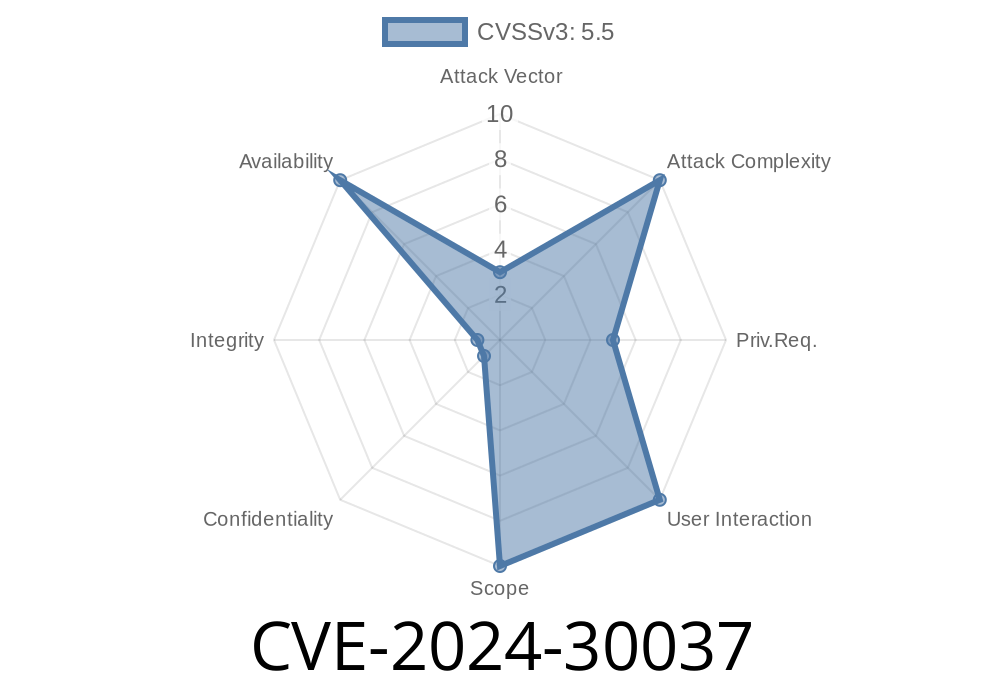In June 2024, Microsoft patched a vulnerability tracked as CVE-2024-30037, which affects the Windows Common Log File System (CLFS) driver. This bug is dangerous because it allows local attackers to gain elevated privileges—in simpler words, normal users or malware can become SYSTEM, the most powerful Windows account.
Below, we explain how CVE-2024-30037 works, include code snippets for demonstration, give you links for further reading, and reveal how real-world exploit code takes over a Windows machine.
What is the Windows Common Log File System (CLFS)?
The CLFS is a Windows kernel component (clfs.sys) that helps manage logs for system and application processes. It's used everywhere—databases, system services, and even in some security products.
Previous years have seen attackers exploiting CLFS bugs for privilege escalation—including several high-profile ransomware gangs. You can read more about CLFS here:
- Microsoft Docs: Common Log File System
Type of bug: Elevation of Privilege (EoP) in clfs.sys
- Microsoft advisory: CVE-2024-30037 Security Update Guide
- Windows versions vulnerable: Windows 10, Windows 11, Server 2016/2019/2022 (before June 2024 patches)
If a normal user can exploit this vulnerability, they can run code as SYSTEM. That means they can
- Disable or uninstall antivirus/security tools
1. Understanding the Vulnerability
The actual bug is in how clfs.sys handles log file metadata. With a specially crafted input, a user-mode process can trigger a memory corruption (like a buffer overflow or use-after-free), corrupt kernel memory, and hijack control to execute their own code in kernel mode.
Open a handle to the CLFS device (\\.\clfs)
- Send a crafted IOCTL (input/output control command) with special data
Trigger the bug—corrupting memory and gaining control
Below is an *educational and simplified* C code snippet that demonstrates the structure. Do not use this maliciously.
#include <windows.h>
#include <stdio.h>
#define CLFS_DEVICE "\\\\.\\clfs"
#define VULN_IOCTL x9032203F // Example—actual IOCTL may vary
int main() {
HANDLE hDevice = CreateFileA(
CLFS_DEVICE,
GENERIC_READ | GENERIC_WRITE,
,
NULL,
OPEN_EXISTING,
FILE_ATTRIBUTE_NORMAL,
NULL
);
if (hDevice == INVALID_HANDLE_VALUE) {
printf("[-] Could not open handle to CLFS device\n");
return 1;
}
char exploitBuf[x100] = {}; // Craft your malicious buffer here
DWORD bytesReturned;
BOOL ok = DeviceIoControl(
hDevice,
VULN_IOCTL,
exploitBuf,
sizeof(exploitBuf),
NULL,
,
&bytesReturned,
NULL
);
if (!ok) {
printf("[-] Exploit failed (IOCTL)\n");
CloseHandle(hDevice);
return 1;
}
printf("[+] IOCTL sent, check for SYSTEM shell\n");
CloseHandle(hDevice);
return ;
}
3. Getting SYSTEM
After corruption, the exploit usually overwrites a function pointer or security descriptor so the attacking process can spawn a shell as SYSTEM. This is what hackers want: complete control.
Exploit modules
There are now open-source and commercial tools with public exploits for previous and new CLFS vulnerabilities.
- Example Metasploit module for similar CVE: Github Link
- Mitre reference: CVE-2024-30037 at NVD
Summary
CVE-2024-30037 is a critical bug in Windows that lets attackers go from a normal account to full SYSTEM control, thanks to a flaw in the CLFS kernel driver. While some technical skill is needed, public exploits are likely. The best protection: update Windows immediately.
References and Further Reading
- Microsoft CVE-2024-30037 Advisory
- NVD CVE-2024-30037 Record
- CLFS Introduction by MS Docs
- Haclabs writeup on similar CLFS bugs
If you’re a defender, patch fast. If you’re a student, study kernel exploitation responsibly. For everyone: never underestimate obscure Windows drivers—they’re prime targets for attackers!
Timeline
Published on: 05/14/2024 17:17:09 UTC
Last modified on: 06/19/2024 20:58:45 UTC
